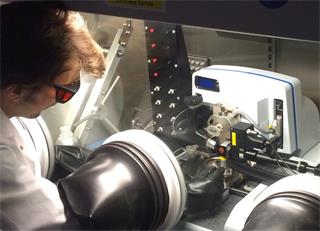No momento esta página não está disponível em seu idioma. Você pode ver uma tradução automatizada utilizando o Google Translate. Não somos responsáveis pelo fornecimento deste serviço e não podemos verificar os resultados.
Se você necessitar mais ajuda fale conosco.
The US Army Research Laboratory combines Raman and AFM
25th November 2015
The US Army Research Laboratory (ARL) in Maryland, USA, is studying electrochemical energy storage materials with a hybrid instrument consisting of a Renishaw inVia confocal Raman microscope and a Bruker Dimension Icon atomic force microscope (AFM).
Dr Collin Becker is a mechanical engineer at ARL. His group studies materials for advanced lithium ion batteries and future-generation energy storage systems, such as sodium ion, magnesium ion and solid-state batteries. His research on lithium ion batteries focuses on developing high capacity anode materials to improve overall energy density, rate of discharge and safety of electrochemical energy storage materials for electronics and vehicles. He also assists colleagues in the electrochemistry branch, characterizing materials such as novel cathode materials and solid-state electrolytes.
Dr Becker investigates in situ changes in materials during battery charge and discharge with his Renishaw/Bruker combined Raman/AFM. This system—unlike scanning electron microscopes (SEM) and x-ray photoelectron spectrometers (XPS)—does not require samples to be in high vacuum. He can therefore use the Renishaw/Bruker system to study cells with standard electrolytes, in an inert environment provided by a glovebox. This provides the most realistic picture of the chemical and mechanical events taking place during battery cycling. He can also use the system to analyse other air and moisture sensitive samples.
Speaking about the key advantage of using the Renishaw inVia system, Dr Becker said, “The capability to use systems like the inVia in an argon-filled glovebox is critical for lithium ion battery materials since they are typically air and moisture sensitive. The ability to do mapping experiments and still be able to have the system coupled with the electrochemical cell used for in situ AFM is very important.”
For further details of Renishaw's inVia confocal Raman microscope, please visit www.renishaw.com/inVia
About Renishaw
Renishaw is one of the world's leading engineering and scientific technology companies, with expertise in precision measurement and healthcare. The company supplies products and services used in applications as diverse as jet engine and wind turbine manufacture, through to dentistry and brain surgery. It is also a world leader in the field of additive manufacturing (also referred to as 3D printing), where it is the only UK business that designs and makes industrial machines which ‘print' parts from metal powder.
The Renishaw Group currently has more than 70 offices in 33 countries, with over 4,000 employees, of which 2,700 people are employed within the UK. The majority of the company's R&D and manufacturing is carried out in the UK and for the year ended June 2015 Renishaw achieved sales of £494.7 million of which 95% was due to exports. The company's largest markets are the USA, China, South Korea, Germany and Japan.
The Company's success has been recognised with numerous international awards, including eighteen Queen's Awards recognising achievements in technology, export and innovation. Renishaw received a Queen's Award for Enterprise 2014, in the Innovations category, for the continuous development of the inVia confocal Raman microscope. For more information visit www.renishaw.com
Downloads
For more images, videos or information on Renishaw and its products, visit our mediahub.

